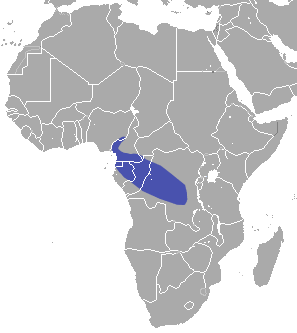Eisentraut's striped mouse or Eisentraut's hybomys is a species of rodent in the family Muridae. It is found only in Cameroon. Its natural habitat is subtropical or tropical moist montane forests. It is threatened by habitat loss.
The Cameroon soft-furred mouse or Cameroon praomys is a species of rodent in the family Muridae. It is found in Cameroon and Equatorial Guinea. Its natural habitat is subtropical or tropical moist montane forests. It is threatened by habitat loss.
The gray-tailed narrow-headed rat is a species of rodent in the family Muridae. It is found only in Ethiopia. Its natural habitats are subtropical or tropical moist montane forests, subtropical or tropical high-elevation shrubland, and subtropical or tropical high-elevation grassland. It is threatened by habitat loss.

The charming thicket rat is a species of rodent in the family Muridae. It is described as data deficient as Thamnomys schoutedeni. It is found in Democratic Republic of the Congo, Rwanda, and Uganda. Its natural habitat is subtropical or tropical moist montane forests. It is threatened by habitat loss.

Villa's gray shrew is a shrew native to northeastern Mexico, where it is called musaraña.
Bombina microdeladigitora is a species of toad in the family Bombinatoridae endemic to Guangxi, Hubei and Sichuan in China. It is commonly known by several names including Guangxi firebelly toad, Hubei firebelly toad, large-spined bell toad, Lichuan bell toad, small-webbed bell toad, and Yunnan firebelly toad. Its natural habitats are subtropical or tropical moist montane forests, temperate forests, rivers, swamps, and freshwater marshes. It is threatened by habitat loss.

Aplastodiscus albosignatus, also known as the Bocaina treefrog, is a species of frog in the family Hylidae. It is endemic to Brazil. Its natural habitats are subtropical or tropical moist lowland forests, subtropical or tropical moist montane forests, and rivers. It is threatened by habitat loss.
The Kern Plateau salamander is a species of salamander in the family Plethodontidae, endemic to California, in Tulare and Inyo, and Kern Counties in the western United States.

The long-snout torrent frog is a species of frogs in the family Ranidae.
Platymantis bimaculatus is a species of frog in the family Ceratobatrachidae. It is endemic to West Papua, Indonesia.
The Tawitawi brown dove is a threatened species of bird in the family Columbidae noted for its orange-peach breast. It is endemic to forests in the Sulu Archipelago in the Philippines. Until recently it was considered conspecific with the Mindanao brown dove and collectively called the dark-eared brown dove. Although threatened by habitat loss, the rate of loss significantly reduced from 2004 to 2007, and it was thus downlisted from Critically Endangered to Endangered status in the 2007 IUCN Red List.

The Ugandan lowland shrew or Moon shrew, is a species of mammal in the family Soricidae. It is found in Kenya and Uganda. Its natural habitats are subtropical or tropical swamps and montane forests.

The Mount Cameroon forest shrew or arrogant shrew, is a species of mammal in the family Soricidae endemic to Cameroon. Its natural habitat is subtropical or tropical moist montane forests.

The greater forest shrew is a species of mammal in the family Soricidae found in Cameroon, the Central African Republic, the Republic of the Congo, Equatorial Guinea, Gabon, and Nigeria. Its natural habitat is subtropical or tropical moist lowland forest.
Asteropeia amblyocarpa is a species of plant in the Asteropeiaceae family. It is endemic to Madagascar. Its natural habitats are subtropical or tropical dry forests and rural gardens. It is threatened by habitat loss. It is included in several national parks.
Asteropeia densiflora is a species of plant in the Asteropeiaceae family. It is endemic to Madagascar. Its natural habitat is subtropical or tropical high-altitude shrubland. It is threatened by habitat loss.
Asteropeia matrambody is a species of plant in the Asteropeiaceae family. It is endemic to Madagascar. Its natural habitat is moist lowland forest. It is threatened by habitat loss.
Asteropeia micraster is a species of plant in the Asteropeiaceae family. It is endemic to Madagascar. The plant's natural habitat is sandy shores.
Asteropeia multiflora is a plant species in the Asteropeiaceae family. It is endemic to Madagascar. Its natural habitat is sandy shores.

Ambohitantely Special Reserve is a 5,600-hectare (14,000-acre) wildlife reserve of Madagascar.








